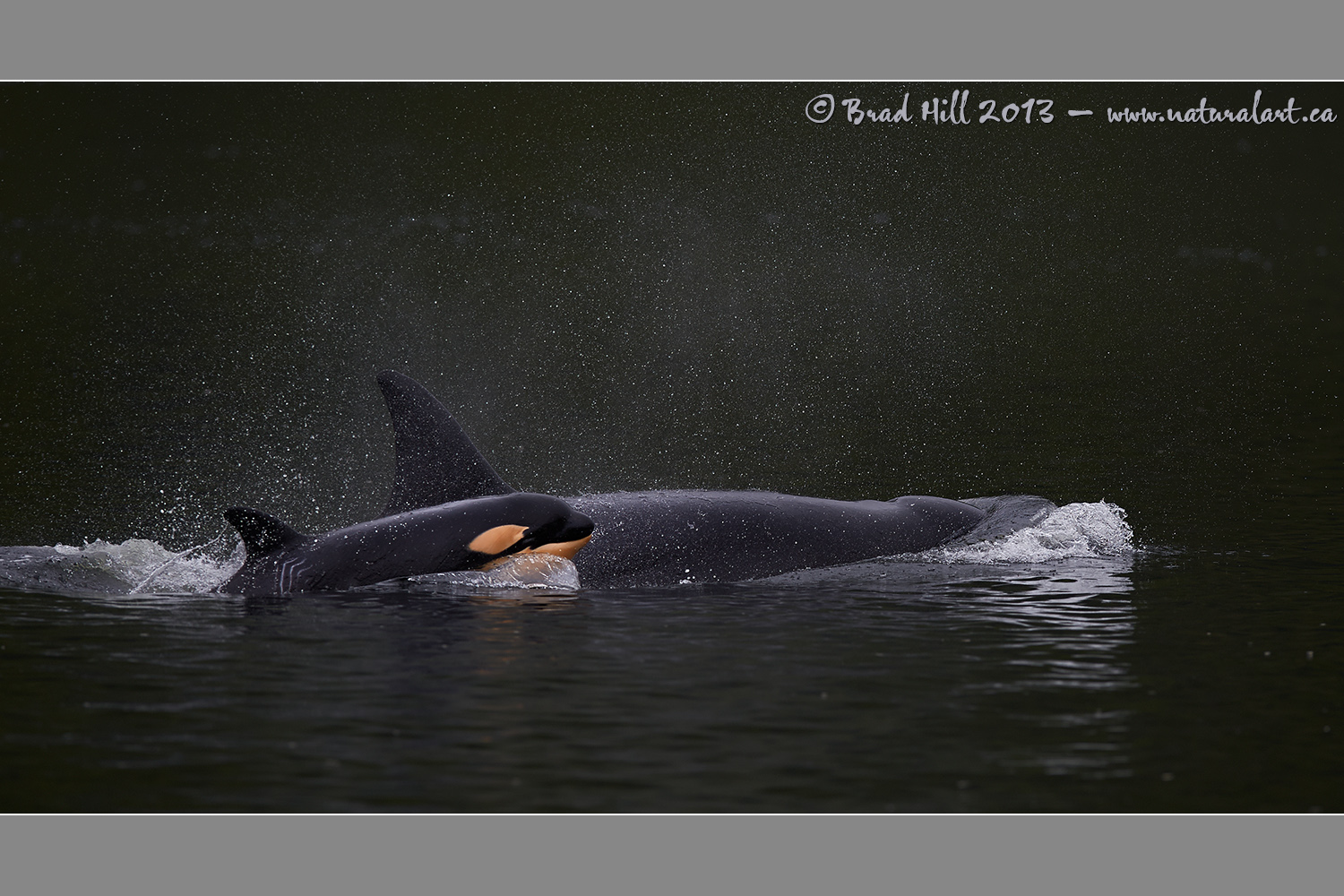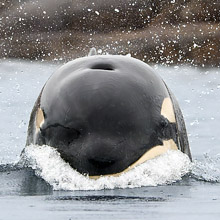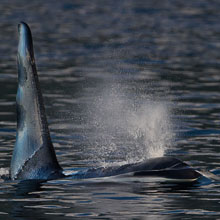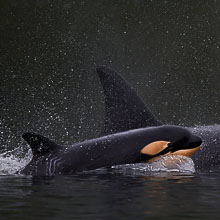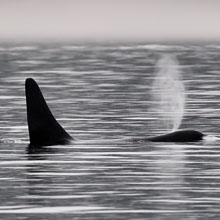Availability: Undetermined - Enquiries?
In the Field
I'm a Coming! Great Bear Rainforest, BC, Canada. October 11, 2013
This image captures a young Orca (or Killer Whale) calf as it swims alongside - and slightly behind - its mother. We watched this pair of Orcas, along with 3 others that were accompanying them, for a good half hour while they were continuously moving down a long channel. Although the small pod was moving very rapidly and although junior always seemed to be a little behind his mom and seemed to be struggling to keep up, it never really fell far behind. What's with the orange patches on the calf? When Orcas are very young their cheek and lower jaw/throat patches are yellow-orange, rather than the bold and contrasting white patches found on adults. This little tyke is also "wearing" a bit of history - just below its dorsal fin one can clearly see white scratches which look suspiciously like the teeth marks from another Orca. It makes one wish the little guy could talk (or "talk in a language we can understand") and tell us its version of how it got the scratch marks!
Sadly, future generations may not have the privilege of seeing - or photographing - a scene like this. The Orcas shown here are members of one of the Northern Resident pods that live off the coast of BC. The Northern Residents are officially listed as threatened with extinction. Both resident (fish-eating) and transient (mammal-eating) Orcas are found near the top of the food chain. Unfortunately, there's a very negative and possibly deadly consequence to being an apex predator in our increasingly polluted oceans - as one progresses up the food chain from algae to algae eaters and up to the carnivores, any pollutants and toxins in the water become increasingly concentrated in the flesh of animals. Because Orcas natural lifespan is very long (easily over 50 years), they have years and years to concentrate massive quantities of toxins in their bodies. How bad is this concentration of toxins in Orcas? Real bad - if you encounter a dead Orca on a beach keep back - it's only safe to approach it with a biohazard suit on (really). What impact does this concentration of toxins have on the reproductive success of female Orcas? While this isn't fully understood, it would be pretty hard to argue that it's helping the Orcas survive.
To make matters worse for these Orcas, a proposal to bring oil super-tankers carrying a toxic product called diluted bitumen though the very waters this image was shot in is currently being considered. The proposal is very controversial and is facing strong opposition by the residents of British Columbia, especially the First Nations that will be most directly impacted by the super-tankers (and the pipelines needed to bring the diluted bitumen from Alberta to the coast).
Orcas or oil for export to China? Some would argue it's not a simple either-or decision. Past history would suggest it is. Find out more - including what YOU can do to help stand up for the Orcas and for the Great Bear Rainforest - right here:
• http://www.pipeupagainstenbridge.ca
Looking for a higher resolution version of this image (for use in your OWN personal campaign to save both the Orcas and Great Bear Rainforest)? Here you go:
• I'm a Coming! Download 2400 pixel image (JPEG: 1.2 MB)
ADDITIONAL NOTES:
1. This image - in all resolutions - is protected by copyright. I'm fine with personal uses of it (including use as desktop backgrounds or screensavers on your own computer), but unauthorized commercial use of the image is prohibited by law. Thanks in advance for respecting my copyright!
2. Like all wildlife photographs on this website, this image was captured following the strict ethical guidelines described in The Wildlife FIRST! Principles of Photographer Conduct. I encourage all wildlife photographers to always put the welfare of their subjects above the value of their photographs.
3. This image was captured during my "Humpback, Orcas, Sea Lions & More" photo tour in August of 2013. Each year I offer trips into two different parts of the Great Bear Rainforest as well as one to photograph aquatic mammals and oceanscapes near the northern tip of Vancouver Island. And, in selected years, I also offer photo tours to locations to capture other highly sought-after subjects, such as various owl species of the boreal forest and wildlife of Canada's Arctic. Details about these trips can be found on the Photo Tours page of this website.
Behind the Camera
I'm a Coming! Great Bear Rainforest, BC, Canada. October 11, 2013
Digital Capture; Compressed RAW (NEF) 14-bit format; ISO 360.
Nikon D4 paired with Nikkor 400mm f2.8G VR lens. Hand-held from sailboat. VR on and in normal mode.
1/1000s @ f5; -1.0 stop exposure compensation from matrix-metered exposure setting.
At the Computer
I'm a Coming! Great Bear Rainforest, BC, Canada. October 11, 2013
RAW Conversion to 16-bit TIFF, including first-pass/capture sharpening using Capture One Pro version 7. Three raw variants (different versions of a single raw capture) differing by a total of 0.67 stop in total exposure.
Further digital corrections on resulting 16-bit TIFF files using Adobe's Photoshop CC and Light Craft's LightZone. Photoshop adjustments included compositing (blending) of the three exposure variants, minor selective colour saturation and desaturation, and sharpening for web output. Final tone tweaking performed using tonemapper/re-light tool in LightZone.
Conservation
I'm a Coming! Great Bear Rainforest, BC, Canada. October 11, 2013
Ten percent of the revenue generated by this image will be donated to Raincoast.
Species Status in Canada*: Endangered - Northeast Pacific southern resident population; Threatened - Northeast Pacific transient population and the Northeast Pacific northern resident population; Special Concern - Northeast Pacific offshore population.
Killer Whales (Orcinus orca) have an extremely high profile in modern pop culture and have become the "poster child" of a number of conservation groups. In most areas where Killer Whales are found they show a remarkable ability to adapt to a variety of habitats - they are found in all oceans, in water ranging in temperature from below 0 Celsius to almost hot tropical waters, and will occasionally even spend significant amounts of time in brackish water or even rivers.
Because the population sizes of Killer Whales are very low and because they have a very low reproductive rate, they face immediate risk from human-related environmental disturbances, including the immunotoxic effects of toxic chemicals we pour into the oceans and to reduction in prey availability (such as salmon).
These two Killer Whales were photographed along the coast in British Columbia's Great Bear Rainforest. The Raincoast Conservation Society is fighting to protect the Great Bear Rainforest along the central and northern coast of British Columbia. This unique ecosystem harbours a strong population of many high-profile species such as Brown Bears and Gray wolves, plus many species that serve as prey for the Killer Whale. If you are looking for a meaningful way to contribute to the conservation of the Great Bear Rainforest and all its associated species, Raincoast will provide maximal "bang" for your conservation dollars.
For more information on the status of Killer Whales in Canada, go to: http://www.speciesatrisk.gc.ca and search under "Killer Whale".
*as determined by COSEWIC: The Committee on the Status of Endangered Wildlife in Canada












